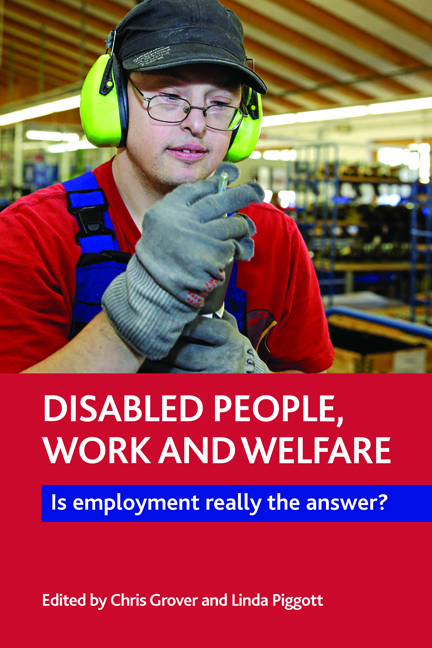Book contents
- Frontmatter
- Dedication
- Contents
- List of tables and figures
- List of abbreviations
- Notes on contributors
- Acknowledgements
- one Disabled people, work and welfare
- Part One Changing constructions of disability and welfare
- Part Two Social policy, work and disabled people
- Part Three Assistance and access to paid work
- Part Four Alternatives to, and validated lives beyond, paid work
- Part Five Conclusion
- Index
ten - Supply- and demand-side policies and the employment of learning disabled people in Britain
Published online by Cambridge University Press: 11 March 2022
- Frontmatter
- Dedication
- Contents
- List of tables and figures
- List of abbreviations
- Notes on contributors
- Acknowledgements
- one Disabled people, work and welfare
- Part One Changing constructions of disability and welfare
- Part Two Social policy, work and disabled people
- Part Three Assistance and access to paid work
- Part Four Alternatives to, and validated lives beyond, paid work
- Part Five Conclusion
- Index
Summary
Introduction
This chapter discusses the position of learning disabled people1 in Britain in relation to the labour market, and supply and demand policies. Welfare policies in Britain have recently sought to reposition many disabled people as potential workers rather than welfare recipients (DWP, 2013b), but there has been much more reticence and ambivalence in relation to learning disabled people. Relatively recent acknowledgement that learning disabled people should be included in ‘work-first’ policies and evidence of the efficacy of some support programmes such as supported employment (OECD, 2010) have not resulted in a large increase in the numbers working, despite clear evidence that learning disabled people have long valued the opportunity to work and to earn money on the same basis as everyone else.
In this chapter, a description of the employment position of learning disabled people is followed by a discussion of the value of work. The chapter then focuses on labour market developments, including flexibility and commodification, and the implications of these for learning disabled people before moving on to consider supply- and demand-side policies. The chapter suggests that while supply-side policies have arguably become more benign and informed, emphasising co-production, inclusion and the importance of community connections, rather than ‘readiness’ to work, they often remain focused on increasing the capacity of individuals, rather than the creation of demand-led opportunities. Without seeking to undermine the importance of individually tailored support, the rest of this chapter discusses the contribution and limitations of demand-side strategies and the contribution of some user-led initiatives. The chapter is mainly concerned with the situation in Britain and with the employment situation of people with labels of ‘moderate’ and ‘severe’ learning difficulties, rather than, for instance, those who may have learning difficulties such as dyslexia (Office for Disability Issues, 2010).
Paid work and learning disabled people
The proportion of learning disabled people in paid work
Establishing the proportion of learning disabled people in paid work is difficult (Emerson et al, 2010). Available data tend to concentrate on the activities of services, rather than outcomes for learning disabled people and their families (Emerson and Hatton, 2008) and different definitions used lead to varying results. Bearing in mind these caveats, learning disabled people consistently have an employment rate – 7.1% in 2011-12 (Emerson et al, 2012) – that is lower than that of disabled people generally (46.3%) and non-disabled people (76.4%) (Office for Disability Issues, 2012).
- Type
- Chapter
- Information
- Disabled People, Work and WelfareIs Employment Really the Answer?, pp. 181 - 198Publisher: Bristol University PressPrint publication year: 2015

